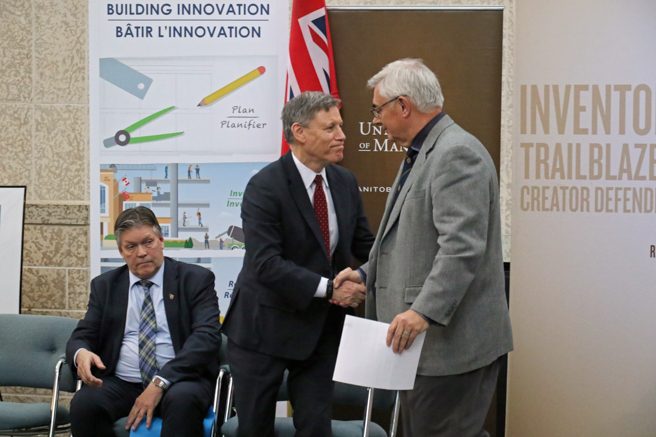The University of Manitoba received a shot in the arm Tuesday, with the announcement of a joint federal-provincial investment of $36 million.
niversity of Manitoba president David Barnard was joined by Winnipeg South Liberal MP Terry Duguid and Manitoba education and training minister Ian Wishart to announce the combined investment – with $32 million coming out of the $2 billion federal p ost-secondary institutions Strategic Investment Fund and $4 million from the provincial Progressive Conservative government.
The majority of the federal injection – $20 million – will go toward the U of M Smartpark Innovation Hub. An additional $12 million will support construction of the new Stanley Pauley Engineering Building.
Duguid, who made the announcement on behalf of the federal government, said the hub will promote innovation and strengthen the Canadian economy.
“This investment will create the right conditions for innovation and long-term growth,” he said. “Our goal is to make every Canadian innovation-ready: ready to spot opportunities, to imagine possibilities, and to discover new ideas.”
The U of M Smartpark is a planned 100-acre research and technology park that leases space to organizations and companies involved in research activities in fields including information and communications technology, engineering and advanced materials, health and biotechnology, and agricultural and nutritional sciences.
The province of Manitoba announced its own $4 million investment into the Stanley Pauley project, with Wishart saying the construction will serve to meet the needs of an increasing number of students studying engineering at the U of M.
He noted enrolment in the faculty has increased by nearly 50 per cent since 2010 and said the centre will give students a leg-up with practical training.
“This new facility will enable collaborative research amongst partners in the centre as well as provide students the opportunity for hands-on experience through internship opportunities,” he said, pointing to the engineering faculty’s long history of strong research partnerships with the private sector.
Barnard thanked both the federal and provincial governments for their contributions, adding that the investments will enable competition and benefit the university.
“The help of both orders of government [is] advancing our efforts to provide Manitoba’s – and Canada’s – future engineers with world class education,” Barnard said.
“Together, this allows the university to continue to affirm its place as a leading research-intensive university with global impact,” he added.
Barnard said the facilities will help the university retain highly skilled students and researchers, support commercialization and professional services, and facilitate collaborations to drive new technologies.
“This will allow us to graduate engineers with a broader experience base, well prepared to become Manitoba’s innovative problem solvers,” he said.
“We have a great deal to celebrate because we are going to see significant benefits from both these projects and that’s a consideration in everything that we do.”

